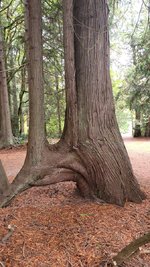Highbidjj
Sapling
Hi all,
I've been casting about for a while now and have not yet found the trees that I can consistently have success with. I think I have decided my primary challenge is how to have thriving trees on my decidedly heavily shaded property. I am hoping some of you here can give me some guidance of where to focus my interest.
I'll explain;
I live about as far North as you can go in the lower 48 U.S. states but my climate here in Puget Sound is very mild, all things considered. I have had the same home for 17 years and I am never moving. I chose this home for its acres of tall timber. I have dozens of mature Douglas Fir, Big Leaf Maples and Red Cedar. They range from 80ft to 200ft tall. It is a very serene and beutiful place. I am very blessed with all the big trees.
BUT! Living so far North means that for half of the year, the sun is on the Southern Horizon all day.
 My property is slightly downslope from the South and the adjacent properties are unspoiled woods. A sunny day in Autumn or Spring consists of a few peekaboo sun beams.
My property is slightly downslope from the South and the adjacent properties are unspoiled woods. A sunny day in Autumn or Spring consists of a few peekaboo sun beams.
I have never lost a plant to freezing and barely protect them, just move the pots close to the house, setting on the garden dirt.
But all of my attempts at the likes of JPB just fade away over a few years.
Vine Maples and Azaleas do ok. Hemlocks and Spruce have been modest. But, it seems that most things I bring home just slowly fade away.
Thoughts?
I've been casting about for a while now and have not yet found the trees that I can consistently have success with. I think I have decided my primary challenge is how to have thriving trees on my decidedly heavily shaded property. I am hoping some of you here can give me some guidance of where to focus my interest.
I'll explain;
I live about as far North as you can go in the lower 48 U.S. states but my climate here in Puget Sound is very mild, all things considered. I have had the same home for 17 years and I am never moving. I chose this home for its acres of tall timber. I have dozens of mature Douglas Fir, Big Leaf Maples and Red Cedar. They range from 80ft to 200ft tall. It is a very serene and beutiful place. I am very blessed with all the big trees.
BUT! Living so far North means that for half of the year, the sun is on the Southern Horizon all day.

 My property is slightly downslope from the South and the adjacent properties are unspoiled woods. A sunny day in Autumn or Spring consists of a few peekaboo sun beams.
My property is slightly downslope from the South and the adjacent properties are unspoiled woods. A sunny day in Autumn or Spring consists of a few peekaboo sun beams.I have never lost a plant to freezing and barely protect them, just move the pots close to the house, setting on the garden dirt.
But all of my attempts at the likes of JPB just fade away over a few years.
Vine Maples and Azaleas do ok. Hemlocks and Spruce have been modest. But, it seems that most things I bring home just slowly fade away.
Thoughts?


